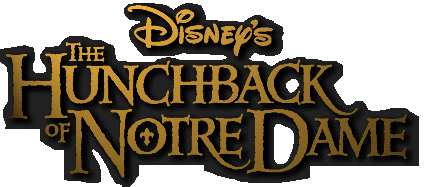
Cast * Interesting Facts * Getting the Gargoyles Right * Victor Hugo's novel * The Musical! * Interview with a storyboard artist

Cast * Interesting Facts * Getting the Gargoyles Right * Victor Hugo's novel * The Musical! * Interview with a storyboard artist

Directed by: Gary Trousdale & Kirk
Wise
Written by: Victor Hugo & Irene Mecchi
Music by: Alan Menken & Stephen Schwartz
Released on: June 21, 1996
Running Time: 90 minutes
Budget: $70 million
U.S. Opening Weekend: $21.3 million
Box-Office: $121 in the U.S., $303 million
worldwide
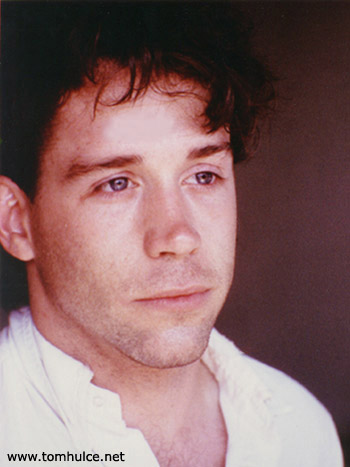 |
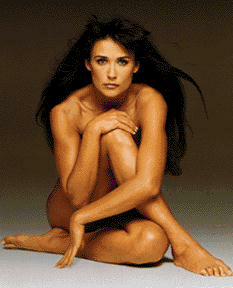 |
 |
 |
 |
Quasimodo...
Tom Hulce
Esmeralda... Demi Moore (acting) &
Heidi Mollenhauer (singing)
Judge Claude Frollo... Tony Jay
Captain Phoebus... Kevin Kline
 Clopin...
Paul Kandel
Clopin...
Paul Kandel
Hugo... Jason Alexander
Victor... Charles Kimbrough
Laverne... Mary Wickes (& Jane Withers
for additional dialogue)
The Archdeacon... David Ogden Stiers
Misc. Guards and Gypsies... Jim Cummings
The Old Heretic... Gary Trousdale
![]() According to Jim
Hill Media, "back in the early 1990s, there were a number of animators
at Walt Disney Studios who were pushing for Hunchback to become
the studio’s very first really adult piece of animation. A feature length
animated film that actually dared to take a few chances. Pieces of the
version that these guys wanted to do still remain in the finished film
[like the 'Hellfire' sequence]. But as this project made its way through
the studio’s pre-production pipeline, WDFA management started to get a
little nervous. A Disney animation film without any comic sidekicks and/or
cute little animal friends? Would audiences actually go for that? More
to the point, what about all the money that the Mouse would potentially
miss out on if Hunchback didn’t cough up a few marketable characters?
Friends of Quasi that could be reproduced as ceramics, plush and/or turned
into cute little promotional toys that could be dropped into Burger King
Kids Club meals. So it was about this time that studio execs began leaning
on the Hunchback production team to 'cute up' their project. What
some animators actually resent about Hunchback's gargoyles is--because
they had to make room for these comic characters in the movie--a lot of
the more adult, edgier material had to fall by the wayside. Which, at least
to the point of view of animation veterans like Mr. Ranieri, was to the
detriment of the finished film."
According to Jim
Hill Media, "back in the early 1990s, there were a number of animators
at Walt Disney Studios who were pushing for Hunchback to become
the studio’s very first really adult piece of animation. A feature length
animated film that actually dared to take a few chances. Pieces of the
version that these guys wanted to do still remain in the finished film
[like the 'Hellfire' sequence]. But as this project made its way through
the studio’s pre-production pipeline, WDFA management started to get a
little nervous. A Disney animation film without any comic sidekicks and/or
cute little animal friends? Would audiences actually go for that? More
to the point, what about all the money that the Mouse would potentially
miss out on if Hunchback didn’t cough up a few marketable characters?
Friends of Quasi that could be reproduced as ceramics, plush and/or turned
into cute little promotional toys that could be dropped into Burger King
Kids Club meals. So it was about this time that studio execs began leaning
on the Hunchback production team to 'cute up' their project. What
some animators actually resent about Hunchback's gargoyles is--because
they had to make room for these comic characters in the movie--a lot of
the more adult, edgier material had to fall by the wayside. Which, at least
to the point of view of animation veterans like Mr. Ranieri, was to the
detriment of the finished film."
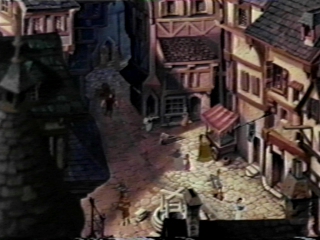
![]() Belle appears during the film's second musical number, the sequence in
which Quasimodo sings "Out There" from atop the roof of the Notre Dame
cathedral. As the camera slowly pans down and along a street reminiscent
of Belle's home town in Beauty and
the Beast towards a small group of people, Belle appears in the
bottom right-hand corner of the screen, walking and reading a book (and
wearing her blue dress, of course). In the same scene, a sharp-eyed viewer
can catch glimpses of a rooftop satellite dish, The
Lion King's Pumbaa being carried by two men with a pole, roasted
pig style, and a street merchant shaking out the flying carpet from Aladdin.
Origins: Another of the self-referential bits of humor that have appeared
in Disney films (most notably Aladdin)
of late, Belle's cameo reportedly came about after a storyboard artist
included her in the scene as a joke because both Beauty
and the Beast and The Hunchback of Notre Dame are set in
France (albeit in quite different time periods).
Belle appears during the film's second musical number, the sequence in
which Quasimodo sings "Out There" from atop the roof of the Notre Dame
cathedral. As the camera slowly pans down and along a street reminiscent
of Belle's home town in Beauty and
the Beast towards a small group of people, Belle appears in the
bottom right-hand corner of the screen, walking and reading a book (and
wearing her blue dress, of course). In the same scene, a sharp-eyed viewer
can catch glimpses of a rooftop satellite dish, The
Lion King's Pumbaa being carried by two men with a pole, roasted
pig style, and a street merchant shaking out the flying carpet from Aladdin.
Origins: Another of the self-referential bits of humor that have appeared
in Disney films (most notably Aladdin)
of late, Belle's cameo reportedly came about after a storyboard artist
included her in the scene as a joke because both Beauty
and the Beast and The Hunchback of Notre Dame are set in
France (albeit in quite different time periods).
![]() Kirk Wise, Gary Trousdale, and Don Hahn confirmed that Donald Duck and
Goofy are hidden as gargoyle statues on the second level of Notre Dame.
This is in the scene when Quasimodo helps Esmeralda and Djali escape the
cathedral by carrying them and jumping over the railing of the top floor.
When all 3 of them are hanging there from the edge, Esmeralda and Djali
look downward and the camera shows what they're seeing through their eyes
as they are dangling there high above the ground. Right after Quasi says
"The trick is not to look down," the screen rocks back and forth a little
bit and there are some gargoyle figures located about halfway down the
cathedral on a lower level balcony.
Kirk Wise, Gary Trousdale, and Don Hahn confirmed that Donald Duck and
Goofy are hidden as gargoyle statues on the second level of Notre Dame.
This is in the scene when Quasimodo helps Esmeralda and Djali escape the
cathedral by carrying them and jumping over the railing of the top floor.
When all 3 of them are hanging there from the edge, Esmeralda and Djali
look downward and the camera shows what they're seeing through their eyes
as they are dangling there high above the ground. Right after Quasi says
"The trick is not to look down," the screen rocks back and forth a little
bit and there are some gargoyle figures located about halfway down the
cathedral on a lower level balcony.
![]() "It goes back to--rightly or wrongly--the inspiration from Victor
Hugo, the idea that Quasimodo in his mind’s eye saw the gargoyles as his
companions," recalled producer Don Hahn in a March 2003 interview. "The
audience knew that they were stone and not alive at all, but we felt like
in the middle of the movie we needed to somehow go into Quasimodo’s fantasy
of what he was going to get if he ever got his freedom. That’s why it’s
art directed the way it is, so it’s very theatrical, and it doesn’t take
place in a realistic Notre Dame. It’s meant to go into his mind, how he
feels that day when he thinks Esmerelda might see something in him. We
wanted a balance of sacred and profane. You wanted a balance between Frollo
and his motivation and Quasimodo and his child-like approach to life. 'A
Guy Like You' was an attempt to do that, to show what’s going on in his
head, like 'Hellfire' was an attempt to show Frollos’ head."
"It goes back to--rightly or wrongly--the inspiration from Victor
Hugo, the idea that Quasimodo in his mind’s eye saw the gargoyles as his
companions," recalled producer Don Hahn in a March 2003 interview. "The
audience knew that they were stone and not alive at all, but we felt like
in the middle of the movie we needed to somehow go into Quasimodo’s fantasy
of what he was going to get if he ever got his freedom. That’s why it’s
art directed the way it is, so it’s very theatrical, and it doesn’t take
place in a realistic Notre Dame. It’s meant to go into his mind, how he
feels that day when he thinks Esmerelda might see something in him. We
wanted a balance of sacred and profane. You wanted a balance between Frollo
and his motivation and Quasimodo and his child-like approach to life. 'A
Guy Like You' was an attempt to do that, to show what’s going on in his
head, like 'Hellfire' was an attempt to show Frollos’ head."
![]() Some
people have already noticed the little tribute to The Wizard of Oz
(1939) in The Hunchback of Notre Dame when Laverne summons the pigeons
to attack the guards during the final fight scene at the end of the film.
Parts of this scene also were a tribute to Alfred Hitchcock's film The
Birds (1963) and you can see the similarity to the classic horror film
when the guards are running from the attacking pigeons.
Some
people have already noticed the little tribute to The Wizard of Oz
(1939) in The Hunchback of Notre Dame when Laverne summons the pigeons
to attack the guards during the final fight scene at the end of the film.
Parts of this scene also were a tribute to Alfred Hitchcock's film The
Birds (1963) and you can see the similarity to the classic horror film
when the guards are running from the attacking pigeons.
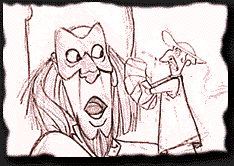
![]() The voice of the old man prisoner that falls into the sewer and says "I'm
free, I'm free! Dangit!" was provided by one of the film's directors, Gary
Trousdale. He also provided the screaming voices of the guards that are
shot through the air, slingshot style, when they chase Esmeralda through
the town square, as well as the screaming voices of the guards that fall
from Notre Dame during the final fight scenes.
The voice of the old man prisoner that falls into the sewer and says "I'm
free, I'm free! Dangit!" was provided by one of the film's directors, Gary
Trousdale. He also provided the screaming voices of the guards that are
shot through the air, slingshot style, when they chase Esmeralda through
the town square, as well as the screaming voices of the guards that fall
from Notre Dame during the final fight scenes.
![]() The gargoyles are named "Victor" and "Hugo", after Victor
Hugo. "Laverne" is the name of the third gargoyle, and also Hugo's
last name.
The gargoyles are named "Victor" and "Hugo", after Victor
Hugo. "Laverne" is the name of the third gargoyle, and also Hugo's
last name.
![]() About 10 percent of the animation was handled by Disney's Paris plant under
supervision of co-producer Roy Conli, freeing up the Florida animation
unit to work full-time on its own productions.
About 10 percent of the animation was handled by Disney's Paris plant under
supervision of co-producer Roy Conli, freeing up the Florida animation
unit to work full-time on its own productions.
![]() According to Jim
Hill, the "Court of Miracle" scene was originally meant to be much
longer, and would have borrowe a story idea from Victor Hugo's novel: Clopin
was going to insist that the only way that Phoebus would be able to escape
death for discovering the whereabouts of the "Court of Miracles" was if
he became a gypsy himself. The only way you can become a gypsy is if you
are born into this way of life and/or if you marry into it. Which is how
Phoebus finds himself plucked from the gallows and plopped in front of
the preacher, who of course, is Clopin. Now the soldier starts to squawk
until he realizes that his bride-to-be is actually Esmeralda. With the
wedding toast complete, all that must be done now to complete the ceremony
is for the King of Fools to give his blessing to the happy couple. Quasi
is clearly reluctant to do this. But thanks to Clopin's constant prodding,
the hunchback finally gives his blessing to Esmeralda and Phoebus. Stephen
Schwartz and Alan Menken actually wrote two different ballads for the movie's
gypsy wedding sequence: "In a Place of Miracles" and "As Long as There's
a Moon", with the hope that at least one of them might catch on with test
audiences and help prevent this particular sequence in the movie from getting
cut. Alas, it was not meant to be. Kids in the test audiences really began
to fidget as soon as the gypsy wedding sequence got underway. It was only
when Frollo and his men entered the "Court of Miracles" that the film finally
won back their attention again. Which ultimately, is why the gypsy wedding
section of the "Court of Miracles" sequence of Disney's "The Hunchback
of Notre Dame" ended up getting cut. Which is why that hand clasping moment
between Quasimodo, Phoebus and Esmeralda later on in the film doesn't pay
off nearly as well as it probably should.
According to Jim
Hill, the "Court of Miracle" scene was originally meant to be much
longer, and would have borrowe a story idea from Victor Hugo's novel: Clopin
was going to insist that the only way that Phoebus would be able to escape
death for discovering the whereabouts of the "Court of Miracles" was if
he became a gypsy himself. The only way you can become a gypsy is if you
are born into this way of life and/or if you marry into it. Which is how
Phoebus finds himself plucked from the gallows and plopped in front of
the preacher, who of course, is Clopin. Now the soldier starts to squawk
until he realizes that his bride-to-be is actually Esmeralda. With the
wedding toast complete, all that must be done now to complete the ceremony
is for the King of Fools to give his blessing to the happy couple. Quasi
is clearly reluctant to do this. But thanks to Clopin's constant prodding,
the hunchback finally gives his blessing to Esmeralda and Phoebus. Stephen
Schwartz and Alan Menken actually wrote two different ballads for the movie's
gypsy wedding sequence: "In a Place of Miracles" and "As Long as There's
a Moon", with the hope that at least one of them might catch on with test
audiences and help prevent this particular sequence in the movie from getting
cut. Alas, it was not meant to be. Kids in the test audiences really began
to fidget as soon as the gypsy wedding sequence got underway. It was only
when Frollo and his men entered the "Court of Miracles" that the film finally
won back their attention again. Which ultimately, is why the gypsy wedding
section of the "Court of Miracles" sequence of Disney's "The Hunchback
of Notre Dame" ended up getting cut. Which is why that hand clasping moment
between Quasimodo, Phoebus and Esmeralda later on in the film doesn't pay
off nearly as well as it probably should.
![]() Composer Alan
Menken commented in January 2002 that "[it is], I think, is the most ambitious
score I've ever written."
Composer Alan
Menken commented in January 2002 that "[it is], I think, is the most ambitious
score I've ever written."
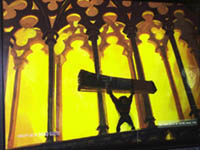
![]() Disney supposedly
asked lyricist Stephen Schwartz to tone down the lyrics of "Hellfire".
Alan also wrote three different unused songs, including "As Long as
Disney supposedly
asked lyricist Stephen Schwartz to tone down the lyrics of "Hellfire".
Alan also wrote three different unused songs, including "As Long as
There's a Moon" which was to be a wedding song based on gypsy traditions.
Stephen Schwartz commented: "I was never asked to censor any of the lyrics
for "Hellfire", though there was some nervousness about the song's preventing
the movie from getting a G rating. (Actually, we tend to think now it would
have been better to have gotten a PG rating for that film anyway.) There
was some re-animation done of the song to make it a little less sexually
explicit (if a cartoon of a girl made of dancing flames can be said to
be explicit). As for the songs Alan and I tried in order to have a love
song for Esmeralda and Phoebus in the Court of Miracles sequence: we ran
into the same problem there we had with 'If I
Never Knew You.' We finally have seemed to solve it for the stage version
now playing in Berlin, partly because the demands of stage are different
and partly because we found a way to include Quasimodo in the song, which
is called 'Out of Love'."
![]() With 12 million visitors a year, Notre Dame de Paris receives about as
many guests as Disneyland Paris?
With 12 million visitors a year, Notre Dame de Paris receives about as
many guests as Disneyland Paris?
![]() A live-action musical version, based on both the Disney animated
feature version and the company's musical, is being developped by ABC since
May 2001. If the script is greenlit, a young Quasimodo is expected
to be cast instead of the traditional middle-age lead. The tone of the
project is expected to fall somewhere in between the lighthearted movie
and the darker Berlin tuner. Alan Menken and Stephen Schwartz will write
the music and lyrics for the project, as they did for the feature and musical.
"If you look at us, we've got a TV network, an animation division, a live
action division, theme parks, New York stage productions and ice
shows," said Thomas Schumacher, co-president of Disney Theatrical Prods.
and feature animation president. "Could any one of our properties
end up in more than one place? It's logical. Everything that we do gets
looked at,'' Schumacher said. ''It's just the way we run the company. Each
one of the platforms is economically viable.''
A live-action musical version, based on both the Disney animated
feature version and the company's musical, is being developped by ABC since
May 2001. If the script is greenlit, a young Quasimodo is expected
to be cast instead of the traditional middle-age lead. The tone of the
project is expected to fall somewhere in between the lighthearted movie
and the darker Berlin tuner. Alan Menken and Stephen Schwartz will write
the music and lyrics for the project, as they did for the feature and musical.
"If you look at us, we've got a TV network, an animation division, a live
action division, theme parks, New York stage productions and ice
shows," said Thomas Schumacher, co-president of Disney Theatrical Prods.
and feature animation president. "Could any one of our properties
end up in more than one place? It's logical. Everything that we do gets
looked at,'' Schumacher said. ''It's just the way we run the company. Each
one of the platforms is economically viable.''
![]() Director Jeff
Bleckner, who piloted the Disney TV movie of The Music Man, announced
in January 2003 that production work on the classic Victor Hugo story should
begin in early 2004. Alan Menken and Stephen Schwartz's film score will
be used for the television version. The composers will write some additional
material, as well. Craig Zadan and Neil Meron, who were producers of The
Music Man, Annie and Rodgers & Hammerstein's Cinderella
for Disney, will also produce The Hunchback of Notre Dame. Sally
Robinson and Bleckner, who penned the TV adaptation of the Meredith Willson
musical, will team again to bring Hunchback to the small screen.
Bleckner said both he and Robinson took in the Berlin production of Hunchback,
which closed on June 16, 2002. For the stage version, Alan Menken wrote
nine new songs to go along with the existing tunes from the film. Stephen
Schwartz has penned the lyrics. Back in January 1998, plans were underway
to bring the show to Broadway with James Lapine directing. Nothing came
of that plan and attention shifted to a live-action, television-movie musical
of the material for ABC-TV's "Wonderful World of Disney." No casting has
been decided, but Bleckner said he'd be looking for a young Quasimodo,
one contending with the sexual urges of puberty.
Director Jeff
Bleckner, who piloted the Disney TV movie of The Music Man, announced
in January 2003 that production work on the classic Victor Hugo story should
begin in early 2004. Alan Menken and Stephen Schwartz's film score will
be used for the television version. The composers will write some additional
material, as well. Craig Zadan and Neil Meron, who were producers of The
Music Man, Annie and Rodgers & Hammerstein's Cinderella
for Disney, will also produce The Hunchback of Notre Dame. Sally
Robinson and Bleckner, who penned the TV adaptation of the Meredith Willson
musical, will team again to bring Hunchback to the small screen.
Bleckner said both he and Robinson took in the Berlin production of Hunchback,
which closed on June 16, 2002. For the stage version, Alan Menken wrote
nine new songs to go along with the existing tunes from the film. Stephen
Schwartz has penned the lyrics. Back in January 1998, plans were underway
to bring the show to Broadway with James Lapine directing. Nothing came
of that plan and attention shifted to a live-action, television-movie musical
of the material for ABC-TV's "Wonderful World of Disney." No casting has
been decided, but Bleckner said he'd be looking for a young Quasimodo,
one contending with the sexual urges of puberty.
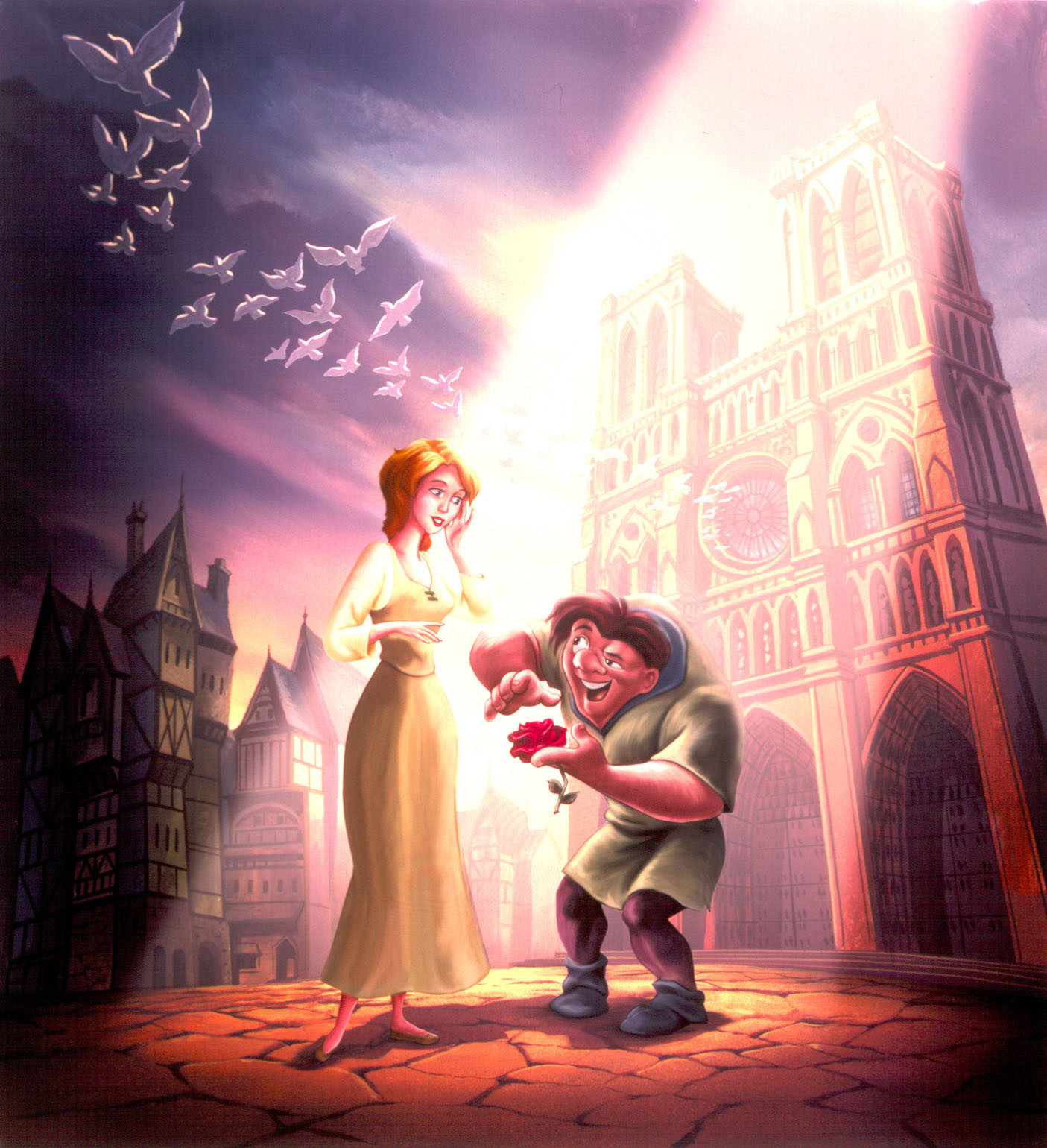 |
 |
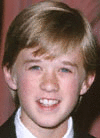 |
![]() Tom Hulce (Quasimodo), Demi Moore (Esmeralda), Kevin Kline (Phoebus), Jason
Alexander (Hugo) and Charles Kimbrough (Victor) all returned in a March
2002 direct-to-video, poorly animated sequel.
Jennifer
Love Hewitt, who starsredas Quasimodo's love interest, the circus performer
Madellaine, aalso co-wrote and performed the film's end-credit song. Haley
Joel Osment(The Sixth Sense,
The
Country Bears) voiced the role of Zephyr, the son of Esmeralda
and Phoebus. In The Hunchback of Notre Dame II, the
people of Paris excitedly anticipate the traditional Jour D'Amour festival
-a celebration of love centered on a beautiful, legendary bell known as
La Fidele. When this jeweled bell is rung, couples step forth to shout
their true love's name. But whose name will Quasi proclaim?
The festival is officially underway with the arrival of Cirque du Sarousch,
a traveling circus. But Sarousch -the vain magician who leads the carnival-
intends to get rich by making off with La Fidele. To distract Quasimodo,
Sarousch sends in his beautiful assistant, Madellaine, to win the bell
ringer's heart. Although Madellaine comes to care for Quasimodo and wants
no part of stealing the bell, Sarousch uses her and takes the bell.
To return the stolen bell, Quasimodo must learn to trust Madellaine, and
in doing so, Quasimodo discovers true love. With Madellaine at his side,
and with the help of his friends Phoebus, Esmeralda, their son Zephyr,
and Quasimodo's gargoyle pals, soon Quasimodo is proclaiming a love for
himself at the Jour D'Amour festival.
Tom Hulce (Quasimodo), Demi Moore (Esmeralda), Kevin Kline (Phoebus), Jason
Alexander (Hugo) and Charles Kimbrough (Victor) all returned in a March
2002 direct-to-video, poorly animated sequel.
Jennifer
Love Hewitt, who starsredas Quasimodo's love interest, the circus performer
Madellaine, aalso co-wrote and performed the film's end-credit song. Haley
Joel Osment(The Sixth Sense,
The
Country Bears) voiced the role of Zephyr, the son of Esmeralda
and Phoebus. In The Hunchback of Notre Dame II, the
people of Paris excitedly anticipate the traditional Jour D'Amour festival
-a celebration of love centered on a beautiful, legendary bell known as
La Fidele. When this jeweled bell is rung, couples step forth to shout
their true love's name. But whose name will Quasi proclaim?
The festival is officially underway with the arrival of Cirque du Sarousch,
a traveling circus. But Sarousch -the vain magician who leads the carnival-
intends to get rich by making off with La Fidele. To distract Quasimodo,
Sarousch sends in his beautiful assistant, Madellaine, to win the bell
ringer's heart. Although Madellaine comes to care for Quasimodo and wants
no part of stealing the bell, Sarousch uses her and takes the bell.
To return the stolen bell, Quasimodo must learn to trust Madellaine, and
in doing so, Quasimodo discovers true love. With Madellaine at his side,
and with the help of his friends Phoebus, Esmeralda, their son Zephyr,
and Quasimodo's gargoyle pals, soon Quasimodo is proclaiming a love for
himself at the Jour D'Amour festival.
GETTING THE GARGOYLES RIGHT PROVES TO BE A GRUESOME GO...
The following article was written by Jim Hill and published at The Laughing Place in April 2000.
"How tough can it be to do the voicework for the comic relief in a Disney animated film?
I mean, what do you do? You show up at the studio, schmooze with the director, say a few jokes, take an hour for lunch, do a few more jokes, break for tea, do another couple of jokes, then -- Oops -- it's time to go home. The hardest part of the job would seem to be that long walk out to the mailbox, where you have to pick up that oversized check.
At least that's what people seem to think happens when actors are hired to do voices for Disney films. The reality of the job is considerably different,- particularly when you're working on a film that's in trouble.
Think of poor Cyndi Lauper. All her life this colorful pop star had
wanted to be in an animated film for Disney. Whenever she went to one of
the studio's film openings or attended a Disneyland press event with her
family Lauper would badger company executives repeatedly telling them "I
want to do a cartoon with you guys." The executives all assured Cyndi that
they knew about her interest. They promised Lauper that once the right
project came along she would be the first person that the Mouse would call.

Cyndi pestered the Mouse for years until, in late 1993, that phone
call she'd been waiting for finally came. Disney was just beginning development
of a musical cartoon version of Victor Hugo's The Hunchback of Notre
Dame. The folks over at Feature Animation were wondering whether Lauper
would be interested in being a part of the project.
Would she? Lauper practically flew over to Burbank, so eager was she to find out what the Mouse had in store for her. On the drive over Cyndi wondered: "They couldn't be thinking of me for the voice of Esmerelda ... could they?"
Ah ... Actually, no. Disney wanted Lauper to audition to be the voice of one of Quasimodo's made-of-stone friends: Quinn, a gargoyle.
Cyndi was somewhat taken aback by this request. I mean, she knew that her voice and her looks were ... somewhat unconventional. But to be considered the perfect person to portray an ugly stone statue didn't seem like much of a compliment to Lauper.
But Cyndi - who still dreamed of achieved screen immortality as a character in a Disney animated film - shrugged off the perceived insult and threw herself into the audition process. She did a reading with Disney's casting department then met with the film's directors, Kirk Wise and Gary Trousdale. They liked the energy and humor Lauper brought to the part. A week later, Cyndi was hired.
Now keep in mind that Ms. Lauper was brought on board fairly early during Hunchback production. Tom Hulce, Demi Moore and Kevin Kline hadn't even been hired at this point. At the time, Wise and Trousdale still weren't quite sure how they were doing with the film. Given how serious the original Victor Hugo novel was they knew that a new film version would need considerable comic relief - particularly if they wanted to make the project palatable to modern audiences. But what sort of jokes should they do to lighten this somber story? And where?
Wise and Trousdale felt that one of the keys to making Hunchback work as animation was to give Quasimodo some silly sidekicks. These characters would have to serve two purposes: 1) Give the Hunchback someone to talk with and confide in while he was locked away in his bell tower, and - more importantly - 2) Make Quasimodo seem more loveable. A person with loyal, funny sidekicks has got to be lovable, right?
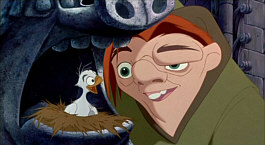 Hoping
to find the right ingredients, the Hunchback development team spent
a few months tossing around sidekick ideas for the hunchback. One concept
was to have Quasi befriended all of the birds that lived up in the rafters
of the cathedral with him. Just like in Cinderella,
his little feathered friends would have helped the hunchback through his
day - doing little chores for him, cheering him up, cheering him on. You
get the idea.
Hoping
to find the right ingredients, the Hunchback development team spent
a few months tossing around sidekick ideas for the hunchback. One concept
was to have Quasi befriended all of the birds that lived up in the rafters
of the cathedral with him. Just like in Cinderella,
his little feathered friends would have helped the hunchback through his
day - doing little chores for him, cheering him up, cheering him on. You
get the idea.
But, because this same bird friend idea had already been so thoroughly played out in Disney's 1950 animated feature Cinderella, Wise and Trousdale opted not to go forward with this story idea (Though you can still see a hint of this character development in Quasi's interaction with the fledgling pigeon at the beginning of the film).
Then the directors toyed with the idea of having Quasi actually be friends with the bells in the tower. This was something that Hugo himself had touched on in the original novel. He had had the hunchback name many of the bells in the belfry - little Sophia, Jean Marie, Anne Marie, Louise Marie and Big Marie - as well as converse with the bells. So it didn't seem like too much of a leap for the film-makers to have the bells talking back to Quasi.
But, again, Wise and Trousdale weren't all that anxious to repeat something that had already been in done in a Disney film. As the directors of Beauty and the Beast, these guys had already made a candelabra, a mantleclock and a teapot talk. So turning a 10 ton bell into Quasi's close intimate friend didn't seem like that much of a challenge to them.
So that left the gargoyles - those strange stone statues that lined the parapets of Notre Dame. Wise and Trousdale liked the idea of giving Quasi some misfit gargoyles - statues so ugly that the stonemason didn't dare put them out on display - to hang out with. The directors and their Hunchback development team knocked around a few ideas and came away with some unique names and personalities for these proposed gargoyle characters. They were:
- Chaney: The big fat stupid one. Think of Pumbaa, only carved in stone.
- Laughton: The haughty, stiff, proper one. A Felix Ungar frieze.
- Quinn: The young, kind-hearted nurturing one. (This was the character Disney had hired Lauper to do the voice for.)
Okay ... I know. You're probably already saying to yourself: "But Jim. Those aren't the names I remember from Disney's animated Hunchback movie. Weren't the gargoyles called Victor, Hugo and Laverne?"
Yes they were ... eventually.
But. when Disney's Hunchback project started out, Kirk and Trousdale wanted to call the movie's gargoyle characters Chaney, Laughton and Quinn. Why? Well, if things had worked out the way Kirk and Gary had intended, these character's names would have made a great in-joke as well as paid tribute to three great actors who already had strong ties to this story.
How so? Well, Lon Chaney starred in the first version of The Hunchback of Notre Dame, a silent movie Universal Studio produced in 1923. Charles Laughton appeared in the first sound version of Hunchback, a black and white film that RKO Studios produced in 1939. And Anthony Quinn made the first color film version of Hunchback, which Allied Artists released in 1957.
Chaney. Laughton. Quinn. Get it now?
Wise and Trousdale thought that by using these names they'd come up with a really clever way to pay tribute to these actors who had already done such a superb job portraying Victor Hugo's tragic hero. Unfortunately, Disney's legal department thought otherwise.
The Mouse's lawyers were worried that Chaney and Laughton's heirs might
be offended by this gesture and decide to sue the studio. They were particularly
concerned about Anthony Quinn - who is very much alive and had a reputation
for suing folks at the drop of a hat - coming after the company with a
army of attorneys.
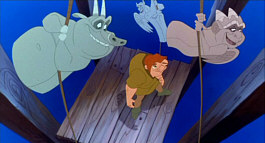
So Disney's lawyers told the Hunchback development team that
there was no way that they'd be allowed to name their gargoyle characters
after any actors -- living or dead. But Kirk and Trousdale were really
reluctant to give up on this gag / tribute. So, for a short time, the Hunchback
gargoyle characters were called Lon, Charles and Anthony. Surely Disney's
legal department wouldn't have a problem if the development team named
the characters by using only the first names of the actors who'd played
Quasimodo?
They could. They did. Disney's legal department said "No" again. Which left the production team with three gargoyles to name.
The Victor & Hugo idea came very quickly. After all, the names paid tribute to the author of The Hunchback of Notre Dame. More to the point, he was a dead guy -- so Hugo wasn't around to try and sue Disney. The legal department LOVED this idea.
But what to call that third gargoyle? Wise and Trousdale pondered over this one for a while. As written, the character was a female as well as being a member of a trio. The name they came up with had to fit the character. More importantly, it had to be funny.
Finally, Kirk was the one who came up with the solution. He recalled the Andrew Sisters, a legendary musical trio from the 1940s - best known for their performance of the Boogie Woogie Bugle Boy of Company B.
And what were the sisters' names? Patty, Maxine and Laverne. Laverne seemed like the funniest name of the three, so that's how Cyndi Lauper's character became known as Laverne.
Only now ... it wasn't so certain that Lauper's character was going to stay Lauper's character.
Cyndi was doing wonderful work in her recording sessions. Good, clear, sharp professional stuff. The problem was that the script - as originally written - wasn't working. The way Lauper was portraying the character, Laverne sounded like a contemporary of Quasimodo. Someone his own age who understood his need to get out of the bell tower and explore that great, big world "Out There."
The trouble was that Cyndi's youthful voice sounded too youthful. Instead of coming across as a friend who was offering Quasi wise counsel, this earlier version of Laverne sounded like some young kid urging Quasimodo to bust out of the belfry and go party. Take a walk on the wild side. Which was not how Wise and Trousdale wanted Laverne to sound, because - in the original version of the script - this was the sort of stuff Hugo was telling Quasi.
As you might have guessed, Wise and Trousdale were having script trouble with their short, fat gargoyle too. They had hired veteran sitcom performer Sam McMurray - best known for his work on The Tracey Ullman Show - to voice Hugo. And Sam was doing a great job with Hugo as the character was written then: sort of a stone version of John Belushi's Bluto character from the 1978 comedy, Animal House. A big, gross, funny guy.
But perhaps too gross. As test versions of Disney's Hunchback
were assembled - using images off of the pre-production storyboards as
well as audio from those early recording sessions - it became obvious that
the gargoyle trio just wasn't jelling. Charles Kimbrough's work as Victor
seemed right on the money. Kimbrough gave his gargoyle character the same
prissy air he brought to his stuffy newscaster character, Jim Dial, on
the CBS sitcom, Murphy Brown. This was exactly what Wise and Trousdale
wanted. But there was something obviously wrong with Hugo and Laverne.
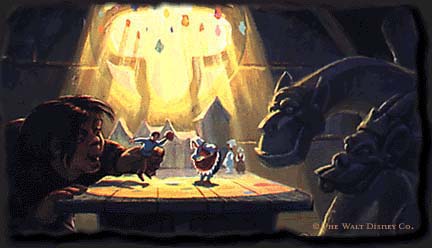
So the Hunchback development team reworked the script then called
Lauper and McMurray back to do some additional recording sessions. When
the tapes from these sessions didn't work out either, Kirk and Gary made
another stab at fixing the script, then called Cyndi and Sam back in again
to have another stab at the material.
When the tapes from these sessions fell flat as well Wise and Trousdale had to face facts. The problem wasn't the material. They'd just hired the wrong actors to perform their script.
It was now obvious that Lauper and McMurray needed to be replaced. While nobody likes to make phone calls like this, Gary and Kirk personally called Cyndi and Sam to let them know that they were off the project. Wise and Trousdale apologized profusely, explaining to Lauper and McMurray that they'd both done fine work. It was just that the characters of Laverne and Hugo - as originally written - weren't working. Disney wanted to see if getting a fresh start on the characters, bringing in some new actors to portray these parts, might be able to get Hunchback back on track.
McMurray took this sad bit of news stoically, like the industry veteran that he is. But Lauper was heartbroken. She had pursued a part in a Disney animated film for nearly a decade. And Cyndi had been on board Hunchback almost from the project's inception - long before Hulce, Moore or Kline had been hired. Now she was out of the movie. Her dream job gone. Needless to say, Lauper took her dismissal very badly.
Wise and Trousdale felt awful about dashing Cyndi's hopes for animation immortality. But they also had a film that was in production that was in serious trouble. Sometimes tough decisions have to be made. So they put the memory of Lauper's tears behind them and tried to figure out how to fix Hugo and Laverne.
Based on the early test footage it was fairly obvious that one of Wise and Trousdale's biggest problems is that they'd just gone too far with Hugo. The fat, obnoxious gargoyle was just coming across as too gross for audiences to warm up to. When recasting Hugo, Gary and Kirk needed to find someone who was gifted at playing annoying but amusing characters that still managed to hold audience's sympathies. But who had talent enough to pull that amazing feat off?
Luckily, they didn't have to look much further than the "Must See TV" line-up Thursday nights on NBC. There was Jason Alexander - playing his heart out as the neurotic but still somewhat loveable George Costanzo on Seinfeld. Here clearly was the man who could pull off Hugo having already walked that thin line between amusing and annoying for five seasons of television.
When Alexander got the call to come out to Burbank and audition he was thrilled. Just like Cyndi, Jason had been trying for years to land a part in a Disney animated film. Previously, he had tried out for the roles of Lefou and Cogsworth in Beauty and the Beast as well as Timon and Pumbaa in The Lion King. But the closest that Alexander had come to making his toon dreams come true was landing the role of the comic villain Abis Mal in the 1994 direct-to-video sequel to Aladdin: The Return of Jafar.
But here, finally, was his big break. So Jason zoomed over to Disney Feature Animation and wowed Wise and Trousdale with his audition. Alexander immediately got Hugo, figuring out - almost instinctively - how far he could take the character without making him too obnoxious. With Jason voicing this grubby little gargoyle, Hugo finally worked. Funny but feisty, Alexander's gargoyle contrasted beautifully with Kimbrough's tight, prissy portrayal of Victor. These two characters could now be counted on to produce huge laughs for the movie.
So now what do Gary and Kirk do with Laverne?
It should be noted here that - at this point in the production - Wise and Trousdale were under tremendous pressure to cut the third gargoyle out of the picture. Given how well Victor and Hugo were now working Laverne suddenly seemed unnecessary. A third wheel, if you will. Dropping that character would have saved the film a lot of money, as well as freeing up a lot more screen time for the two other gargoyles to cavort.
But Gary and Kirk felt Laverne was crucial to the film. Hugo kept urging Quasi to take a chance, go for the gusto. Victor was the voice of prudence and caution. Wise and Trousdale knew that their lead character needed someone in the middle, someone with the common touch who'd tell Quasi just to listen to his heart.
So Hunchback Head of Story Will Finn took a stab at rethinking
Laverne. Working with Trousdale, they re-imagined the female gargoyle not
so much as a nurturing contemporary of Quasi but as a wise - if somewhat
crazy - old grandmother. "The sort of woman who had a million cats and
sat out on her front porch, cradling a shotgun" was how Gary liked to describe
her.

This new version of Laverne looked to be just what Wise and Trousdale
were looking for. Still funny, but obviously different enough from Victor
and Hugo. Plus this rethink of the character - playing her as more of a
favorite old aunt of Quasi - allowed Laverne to deliver that common sense
advice that the lonely young hunchback so desperately needed to hear.
Having finally fixed this troubled character, Gary and Kirk were saddled with an even bigger problem: Who do they find to portray this cranky but kind-hearted old gargoyle?
It was just about this time that the sequel to Disney's 1992 hit, Sister Act - Sister Act 2: Back in the Habit - was hitting theaters. And there - in a supporting role as feisty old Sister Mary Lazarus - was veteran character actress Mary Wickes.
If ever you could call someone an old show business trouper it was Mary Wickes. Her career started way back in the 1940s when Wickes played second banana to Abbott and Costello in their 1941 Universal Studios comedy Hold that Ghost. For the next five decades Wickes never stopped working. She did TV with Lucille Ball, sketch comedy with Bob Hope, movie musicals with Bing Crosby, Broadway, commercials - you name it, Mary Wickes did it.
As soon as Disney Feature Animation's casting office pointed out Wickes to Wise and Trousdale they knew that this might finally be the person who could pull off Laverne. Wickes' reedy mid-western voice along with her crack comic timing might just be the combination Gary and Kirk were looking for to make their third gargoyle work.
Wickes came in for her audition in early 1993. While basically a novice at feature animation (having done a little voice work for TV animation in the early 1990s), Mary still nailed the part. Wickes brought to Laverne everything Wise and Trousdale had hoped she would: the humor, the heart, as well as a real sense of wisdom.
As soon as they heard Wickes' audition tape, Gary and Kirk offered her the part. Being the old show business hand that she was, Mary was happy to just to be working. In spite of being well over 80 years old at the time, Wickes never let her age slow her down. Mary was on time to every session and gave 100% every time she was behind the mike.
Now with Alexander and Wickes on board the gargoyle scenes in Hunchback finally started firing on all four cylinders. Here was the humor and the heart that Wise and Trousdale had been looking for all those months. Finally these early crucial scenes in the film - where Quasi revealed his longing to leave the bell tower and journey Out There into the world - began to play properly.
In fact, the Victor, Hugo and Laverne sequences began working so well that - late in the production, as Hunchback hit a trouble spot - Wise and Trousdale turned to the gargoyles to help bail them out.
Okay. Remember the film? The trouble spot comes up well into the third act of the film. Frollo is burning down Paris in his desperate search for Esmerelda. Phoebus has been shot in the back with an arrow for defying an order from the crazed cleric. Esmerelda ends up rescuing the wounded soldier from a watery grave. Meanwhile, Quasi sit high in his belltower, wringing his hands as he rings his bells, wondering if he'll ever see the beautiful gypsy girl alive again.
Sounds kind of depressing, doesn't it?
If ever a film needed to be lightened up for a while, it was Disney's Hunchback of Notre Dame at this particular point in the plot. So Wise and Trousdale turned their gaze back on their comic relief and thought: "Maybe it's time to give these guys a song."
So they asked composer Alan Menken and lyricist Stephen Schwarz to come up with a comic number for the gargoyles to sing to Quasi as they tried to buck up their pal's spirits as well as distract him - at least for a moment - away from his concerns for Esmerelda's safety. Schwarz then came up with the idea that - in Hugo, Victor and Laverne's eyes - the hunchback was a pretty fine looking fellow.
Out of that notion came the showstopper, A Guy Like You, one of the wildest, funniest numbers ever to be presented in a Disney animated film. Not since Ward Kimball's eye-popping work in the title tune from the studio's 1944 The Three Caballeros has a musical number featured so many gags. That song did just what it was supposed to: diverted Quasi's attention - as well as the audience's - from all the troubles in the film for a few minutes.
This song made the movie all the more heart wrenching when Esmerelda showed up - just moments later - with the injured Phoebus in tow. As the gypsy girl revealed her love for the wounded soldier, our hearts immediately went out to Quasimodo. Just seconds earlier his friends had been assuring the hunchback that Esmerelda had to love him. Now here was the truth - slapping him in the face. It was brutal but still masterful story telling by Wise and Trousdale. You'd have to had a heart of stone to not have been moved by that scene.
Sadly, A Guy Like You would turn out to be the very last thing Mary Wickes worked on. In October 1995, just weeks after recording the song, Wickes passed away quietly in her sleep.
Wickes' death saddened the Hunchback production team, but also left them with a bit of a problem. Prior to her untimely passing, Mary had recorded almost everything that Disney needed to finish the film. But there were still a few additional pick-up lines Wise and Trousdale needed recorded to finish up Laverne's speaking part as well as a couple of lines from A Guy Like You that the directors wanted smoothed over. But, with Wickes gone, how were they ever going to get this additional dialogue recorded?
Since there was obviously no way to replace a talent like Mary Wickes, Disney began searching for a Mary Wickes sound-alike. Happily, the Mouse found one in former child star Jane Withers. Withers - best known these days for her work as Josephine the Plumber, the spokesperson for Comet Cleanser - is a gifted mimic. More to the point, she was a lifelong friend of Mary Wickes, so she could do a killer impression of Wickes' reedy twang without even trying.
Withers was glad to help Disney out of its predicament, both for the
opportunity to work as well as sort of pay tribute to her longtime friend.
Jane came in quietly and quickly recorded the few little snippets of things
Wise and Trousdale needed to finish up Laverne's role in Hunchback.
Withers was so good at doing Wickes that it's damn near impossible to tell
which actress did which part in the movie.
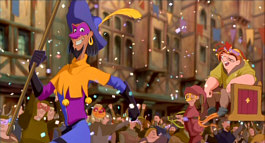
With that ... the gargoyle portions of Hunchback were completed.
The finished film was released in the summer of 1996. While not a huge
hit like The Lion King, Disney's
Hunchback
of Notre Dame got respectful reviews and did okay at the box office.
But one guy really fell in love with this movie: Disney chairman Michael Eisner. Hunchback is - hands down - Eisner's favorite film among all the animated cartoons Disney Studio has created in the 15 years he's been running the company. Michael liked this movie so much that he asked Disney Theatrical Production to create a stage version of the show.
Under the direction of noted Broadway playwright / director James Lapine, a stage version of Disney's Hunchback was produced in 1999. But not in New York. Instead, this live stage version of the movie musical had its world premiere last summer in Berlin. (Why Berlin? Because - of all the countries in all the world - the one place where Disney's animated version of Hunchback was a true blockbuster at the box office was Germany. So when it came time to roll out the live stage version of the show, Berlin seemed like the obvious place to go.)
The live stage version of Disney's Der Glockner Von Notre Dame has proven to be pretty popular with German audiences. The show's been playing to mostly sold out houses since its debut in June 1999 at the Musical Theater Berlin.
Lately, there's been some talk that the Mouse might bring this live stage version of Hunchback stateside to try a run on Broadway. If they do, I do hope that Disney Theatrical gives some thought to offering the part of Laverne to Cyndi Lauper. I mean, come on, fair's fair. Given all the heartbreak Lauper went through with the movie version of this show, it only stands to reason that Cyndi deserves a shot at stardom with the live stage version.
I mean, it isn't starring in a Disney animated cartoon, but it's close.
Besides, by the time Hunchback finally turns up on Broadway,
Lauper will probably be old enough to play Laverne."
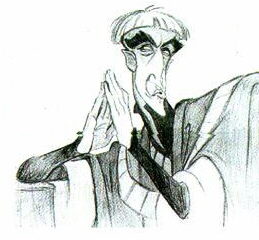 |
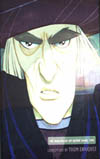 |
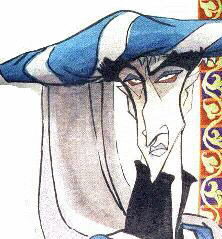 |
VICTOR HUGO'S THE HUNCHBACK OF NOTRE DAME
 Only
28 years old when The Hunchback of Notre Dame was first published
(in 1831), Victor Hugo wrote his sweeping 200,000 word manuscript in just
six months and, it is said, with a single bottle of ink. He got the idea
for the story following a visit to Notre Dame cathedral where he discovered
a cryptic inscription (the Greek word for "fate") carved deep into a stone
wall in the tower. As he pondered the origins and meaning of the message,
a story began to take shape in his mind. Motivated by a desire to re-create
a portrait of medieval Paris for his contemporaries and to gain support
for preserving the Gothic architecture that he so admired, he wove a tale
that is both a rousing historical romance and a psychodrama. Rich in metaphors
emphasizing contrast (dark and light, good versus evil, physical versus
spiritual beauty, sounds and silence), the book provided the Disney creative
team with a wealth of plot and characters along with some of its greatest
storytelling challenges.
Only
28 years old when The Hunchback of Notre Dame was first published
(in 1831), Victor Hugo wrote his sweeping 200,000 word manuscript in just
six months and, it is said, with a single bottle of ink. He got the idea
for the story following a visit to Notre Dame cathedral where he discovered
a cryptic inscription (the Greek word for "fate") carved deep into a stone
wall in the tower. As he pondered the origins and meaning of the message,
a story began to take shape in his mind. Motivated by a desire to re-create
a portrait of medieval Paris for his contemporaries and to gain support
for preserving the Gothic architecture that he so admired, he wove a tale
that is both a rousing historical romance and a psychodrama. Rich in metaphors
emphasizing contrast (dark and light, good versus evil, physical versus
spiritual beauty, sounds and silence), the book provided the Disney creative
team with a wealth of plot and characters along with some of its greatest
storytelling challenges.
DER GLOECKNER VON NOTRE DAME: THE MUSICAL!
Extracts taken from Associated Press, 26 May 1999.
 Der
Glockner Von Notre Dame, the third of the Walt Disney Co.'s animated
films to make the leap from screen to stage after Beauty
and the Beast (1993) and The
Lion King on Broadway (1997), premiered on June 5, 1999 in Berlin,
Germany. Instead of making the product in America and exporting it
around the world, Disney decided to take the idea and create a show in
Germany first, with a German partner, Stella AG.
Der
Glockner Von Notre Dame, the third of the Walt Disney Co.'s animated
films to make the leap from screen to stage after Beauty
and the Beast (1993) and The
Lion King on Broadway (1997), premiered on June 5, 1999 in Berlin,
Germany. Instead of making the product in America and exporting it
around the world, Disney decided to take the idea and create a show in
Germany first, with a German partner, Stella AG.
Stella AG, which pioneered the musical trend by introducing Germans to "Cats" in the mid-1980s, lost $50 million in 1998 and had been run by a consortium of banks since February 1999. Two of its eight shows, "Les Miserables" and "Joseph and the Amazing Technicolor Dreamcoat," closed at the same time and 20 percent of Stella's 5,000 employees were laid off in an attempt to keep the company afloat.
Stella's new management, which invested $25 million in the show, counts on the combination of Disney magic and the revitalized Berlin's tourist appeal to make Der Glockner Von Notre Dame a hit.
"Working in a foreign language -- that's been a big stretch, and we've had to figure out along the way how to do that," says Thomas Schumacher, head of Disney's animation and theatrical productions divisions. "That and the fact that it's far away... makes it more complicated." But a combination of factors supported the decision to break the mold and present an original production in Berlin, he says.
 First,
there was Disney's full plate of productions in the United States, plus
the lure of a brand-new, custom-built theater, and the "appropriateness"
of presenting a classic European story about racism and tolerance in the
former Nazi capital at the same time the German government is making its
historic return to the city. "We wouldn't have been able in this time frame
to do it in the States," Schumacher said in a 1999 interview during rehearsals.
"So it seemed a good idea to be able to do it here and see what we had.
It seems like a good fit." And, he adds, "from a purely business perspective
it's important to have the work out there around the world."
First,
there was Disney's full plate of productions in the United States, plus
the lure of a brand-new, custom-built theater, and the "appropriateness"
of presenting a classic European story about racism and tolerance in the
former Nazi capital at the same time the German government is making its
historic return to the city. "We wouldn't have been able in this time frame
to do it in the States," Schumacher said in a 1999 interview during rehearsals.
"So it seemed a good idea to be able to do it here and see what we had.
It seems like a good fit." And, he adds, "from a purely business perspective
it's important to have the work out there around the world."
Another very important factor that motivated Disney to premiere the show in Europe was the much warmer reception The Hunchback of Notre Dame received there. At the time of the release, many American parents complained that the story -about an evil judge who seeks to rid 15th-century Paris of its Gypsies- was too dark and that references to sexual obsession and stake-burning were inappropriate for children. Yet European audiences flocked to the movie, drawing comparisons with Europe's current struggles with right-wing extremists and violence directed at foreigners. Disney hopes that resonance will carry over to the stage production, which hews even closer to Victor Hugo's 19th-century classic. "I think the values of the piece, and what it's talking about, about acceptance, about a culture that's rethinking itself, I think it's all interesting. I think it's all good stuff," Schumacher says. "Does that fit many places in the world? Absolutely. But it is certainly suited for where we are. That's a pulse that one feels."
Academy Award winners Alan Menken and Stephen Schwartz came up with
nine new songs to fill out the 1996 movie's
score. "We're making an adaptation from the movie, but taking it some
distance from the original," Menken says. "Just in choosing James Lapine
to direct it and write the book, you've already made a major creative decision
there. He's known as a director whose works tend to be very sophisticated,
adult, somewhat intellectual in nature."
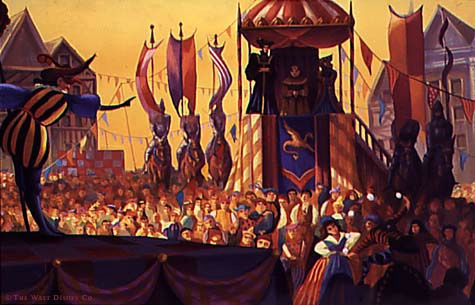 Even
the Disneyfied ending to the movie, in which Esmeralda is rescued from
certain death by a heroic, love-struck Quasimodo, is being rethought. Translator
Michael Kunze, who describes his job as trying to "overcome the gap between
the American writers and the German audience," has been campaigning to
allow Esmeralda to die at the end, as she does in the book. "There was
a feeling that the audience would be depressed if Esmeralda dies," he says.
"I feel that a European audience would see this as a very romantic ending...
two lost souls finally find each other. People will cry, but they'll be
moved. And it is a very romantic ending. And I think this is a mentality
thing, something that's much easier felt and understood in Europe than
in the States."
Even
the Disneyfied ending to the movie, in which Esmeralda is rescued from
certain death by a heroic, love-struck Quasimodo, is being rethought. Translator
Michael Kunze, who describes his job as trying to "overcome the gap between
the American writers and the German audience," has been campaigning to
allow Esmeralda to die at the end, as she does in the book. "There was
a feeling that the audience would be depressed if Esmeralda dies," he says.
"I feel that a European audience would see this as a very romantic ending...
two lost souls finally find each other. People will cry, but they'll be
moved. And it is a very romantic ending. And I think this is a mentality
thing, something that's much easier felt and understood in Europe than
in the States."
Producers have been waiting to see how preview audiences react before making the final decision. "This is the wonderful thing about a new production, you don't know what you end up with," he says. And that's exactly what Disney is waiting to see before deciding whether the show will have a life anywhere beyond Berlin. No further productions -in any language- are even being considered right now. "I'm not going to make those plans until I see the whole show up," Schumacher insists. "We will be as cautious with this and as protective with this as we are with all our products."
In March 2002, Stephen Schwartz confirmed that "Disney now plans
to bring the stage version to the States as well. Of course, this could
change again, but right now, things are looking very positive. It will
probably be a couple of months before i know anything more definitive,
but it is mostly certainly in the active planning stage right now."
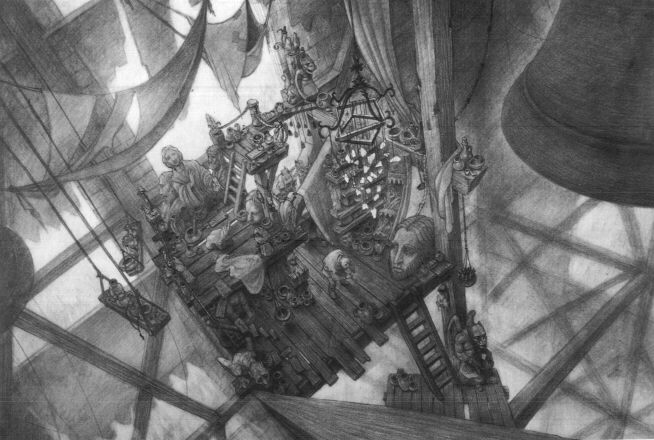 |
 |
INTERVIEW WITH STORYBOARD ARTIST GATEAN BRIZZI
Conducted by Didier Ghez in Montreuil, France on February 26, 1996.
Q: Could you please tell us about your precise role on Hunchback?
We were called, Paul and myself, a short while after production started on Hunchback to work in the US on the storyboard of the movie. When we arrived, the script had already been written and some artists had already began to work on the storyboard. We were given a short sequence of transition that filled Gary Trousdale and Kirk Wise, the directors, with enthusiasm.
Q: From then on they gave us some very important sequences within the whole movie.
Paul and myself were really invested, artistically and emotionally speaking
in this project which lead us to develop a very detailed work on the storyboard.
In general, Disney's storyboards are very rough, very sketchy, very quickly
done. We tried to push the art of storyboarding to its limits. Creating
very precise black and white images for night scenes, with a great care
for light, proportions and details but above all a great attention to the
mood.
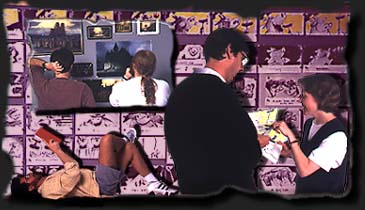
We really worked on the mood that we wanted to be very expressionistic
in the Prologue, which is a very dramatic sequence. We tried to introduce
a kind of artistic vision in terms of visual expression, backgrounds and
characters.
Our role was enlarged to sequence directors. So we came back to Montreuil, after having completed the storyboard, to supervise the sequences that we had storyboarded.
Our first goal, of course, was to be in harmony with the artistic spirit of the directors, Gary and Kirk but also to stay in tone with the style of the artistic director, Dave Goetz. Dave thought we really understood his vision which meant creating a realistic Middle-Age, that is dark and impressive. He wanted to stay out of the cute, round and soft style. He wanted to describe what Paris was at the time: those narrow, gloomy streets that let no light in, with the small dark brooks running inside.
Q: How do you share the work among you, Paul and yourself?
We always work on the same sequence. Here is how. We first discuss about our views about the sequence. Where should it take place ? How should it take place. With words first and a little with the pencil that sketches what we talk about. Then we work alone to find some ideas about key moments in the sequence, to give the scene power and personality.
Then we take a few drawings we really agree about and we really enter the sequence and start developing it, with "post-it", with some papers. This gives us the first draft of our storyboard.
Then we start criticizing. Shouldn't we simplify ? We always want to achieve more simplicity or at least more clarity. What do we want to say with each part of the scene ? What is the message ? What is the information the scene should convey ? Each part of the sequence should only give one bit of information as clearly as possible. This comes into being thanks to setting and light. So we say: "this detail should be seen", so the light will fall on that detail and we will simplify the setting or organize the characters in such a way that the information will become crystal clear.
Mood and light then start to be considered. We suppress all that is superfluous. We remind ourselves of the fact that this part of the sequence will only last one second or two second and that one cannot see all that we had first introduced in that bit.
We simplify again. We have to always remember that we want to tell the story in the best possible way. We are here to tell the story before all, not to make the best possible images. Images must serve the story. They must be powerful but also interesting.
From there on, it's pure pleasure, which means, the storyboard itself. Paul draws more the characters in situation and I dress up the image, by completing the background that surrounds them (without disturbing the readability of the scene) and I add the light, the mood, by working on the blacks and the whites.
We both work on each and every part of the sequence. We sometimes also create some larger-than-usual drawings, paintings like images that underline the key moments of the sequence.
Finally, we call the directors to pitch the sequence.
We have often inherited of the musical sequences, that have no dialogue in them. This was where we took the most pleasure. We had a song as our guide that allowed us to achieve an almost choreographic work on the sequence.
It was what happened for example with "Hell Fire", a scene in which Frolo has this obsessive and ambiguous vision towards Esmeralda, a vision which is as much carnal as it is malevolent. The goal was to show, through this song, the fragility of a Frolo torn-apart between his love and his hate towards Esmeralda. This was a fabulous job, from an artistic point of view.
Q: What were the artistic influences that penetrated your work?
The artistic influences were not directly coming from previous Disney movies. There were more external influences, though. Thanks to Dave Goetz, mainly, who put us on the track of some sort of realism. Artists like Gustave Doré, therefore influenced our style. American artists like Howard Pail, Wyatt, did too with the kind of light they use. Apart from that, Victor Hugo himself through his wash drawings, that are very dramatic. Of course, following all those artists, we had a tendency to be too gloomy. That was the trap the movie could not fall into.
So we had to nuance our inspiration.
Q: Isn't it very difficult, for a Frenchman to adapt Notre Dame de Paris as an animated feature?
It is the easiest possible thing for a Frenchman. It belongs to us, in the sense that it inhabits us. It's gothic, middle-age, Victor Hugo and the powers of the emotions his work convey. His books are full of emotions and even before that of a stupendous background. There are full chapters aimed only at describing the background. You see that this is a crucial part of his works.
So we were very inspired by that and wanted to start drawing right away. However, later on, we had to adapt to the scenario, that was less bleak and pessimistic than Hugo's book (it ends well in the movie). There, the work was even more interesting. We had to find the correct balance between American lightness and French darkness.
And I think we all succeeded to reach our aim which was in part to shake away the cute atmosphere and create a very stunning mood.
Q: What was the hardest part of your work on Hunchback?
Without a doubt it has been the Cour des Miracles (Court of Miracles) sequence. The film makes clear that the gypsies are persecuted but at the same time, in the book, the Cour des Miracles is full of poor French men that rebel against the established Order. The gypsies weren't poor in the movie but had to rebel because they were persecuted. That meant that we had to rethink the Cour des Miracles, to understand what it would be in the movie.
It would become a hideout. But that meant a lot of artistic, scenaristic and moral problems. I think the result, which is a musical result is a very good one.
Q: What was the most interesting sequence?
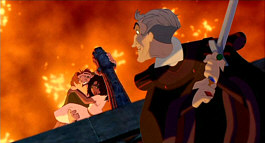
I talked about it earlier on. We thought it would be censured, when
we showed it to the directors, That is the "Hell Fire" sequence, the song
of Frolo, alone in front of the burning hearth, dreaming of Esmeralda dancing.
This is a mix between religion, nightmare, carnal desires which means a
very, very delicate scene to handle. We tried to go as far as possible
in symbolism. That seduced the directors and was approved. It was softened
a bit. But people will probably talk a lot about it.
Q: What were the biggest breakthroughs in Hunchback?
First, you have the evolution of 3D technology in Hunchback. The crowd is a very important part of the movie. We couldn't animate all of them by hand. At the same time, we could not just forget the crowd in middle-age Paris, so it was computer generated. And you can not feel it, really.
For the first time, you have a screen that reacts, has emotions and is in fact computer generated.
Then, there are all the amazing effects with lights, stained glasses and the special effects it involved.
Q: Who is your favorite character in Hunchback?
Well I think I would choose Phebus. The heroic good guy. The animators and the voice of the character really achieved a beautiful job on this character. The voice is very British, very phlegmatic and he was perfectly animated by Russ Elmons who created a very sober character who has a real charisma. It is not the kind of shadowy, weak, uninteresting prince you usually get. Not at all. He is very handsome, very modern and has a lot of panache.
You really understand why Esmeralda falls in love with him.
Q: Could you tell me a little bit about your next projects?
Roy Disney asked Paul and myself to conceive the grand finale of the new Fantasia. We have already started work on this and we will settle in Los Angeles to complete a very ambitious work. The grand finale should be a truly amazing climax. It is a very important responsibility and we are very proud of it.
This sequence should be between 7 and 12 minutes long. We have to choose the music and create a story that stimulate enthusiasm.
Q: Is there a big project you would dream to direct for Disney?
Since we are talking of music, there is our big project of the Enchanted Flute by Mozart. It's a very old project, maybe too old now.
Our idea, in fact, would be to direct an animated feature based on a modern opera. It would not be a Musical, as ever but really an adaptation of a modern opera with classical rock music.
Q: Was it difficult to work with the Americans?
It is very easy to work with the Americans. You have to show them what you can do, then communication is easy. Moreover they give you time, which is crucial for an artist.
There are cultural differences, they do not like when a subject is too gloomy or too ambiguous, whereas, we enjoy messages with two meanings. The American public is also different, as it has a different sensibility to humor and is moved more easily. In France you have this tendency of being more cautious towards pure emotion, they are not afraid of pure emotion.
Some sequences that the American will like, like one of the comic sequences that feature the Gargoyles the French will probably dislike.
We would not have been at ease on funny sequences, as you understood. But give us a good massacre, a good fight, good suspense, and we are at our best. We were very inspired, for example by this very Hitchcockian scene when Frolo interrogates Quasimodo without showing that he is doing so. The Americans are much more skilled than we are for comic sequences.
Q: What are your dreams for the future of Disney?
More success, more evolution from movie to movie. Today everybody wants to do like Disney. But the studio that evolves the quickest is Disney. Disney leaves artists express themselves more and more and this is wonderful.
I hope also that Walt Disney Animation France, within two to three years
will produce a whole animated feature. From the way things are going this
will happen, since the artists here are really now as good as those in
the US. They are asked to give the best and this is what they want and
like to do.
|
||||||||||||